How to Dehydrate Pineapple
This post may contain affiliate links.
Enjoy all the bright, tropical flavor of pineapple without the mess! Dehydrated pineapple is a fun and portable snack that’s perfect for all types of outdoor adventures!
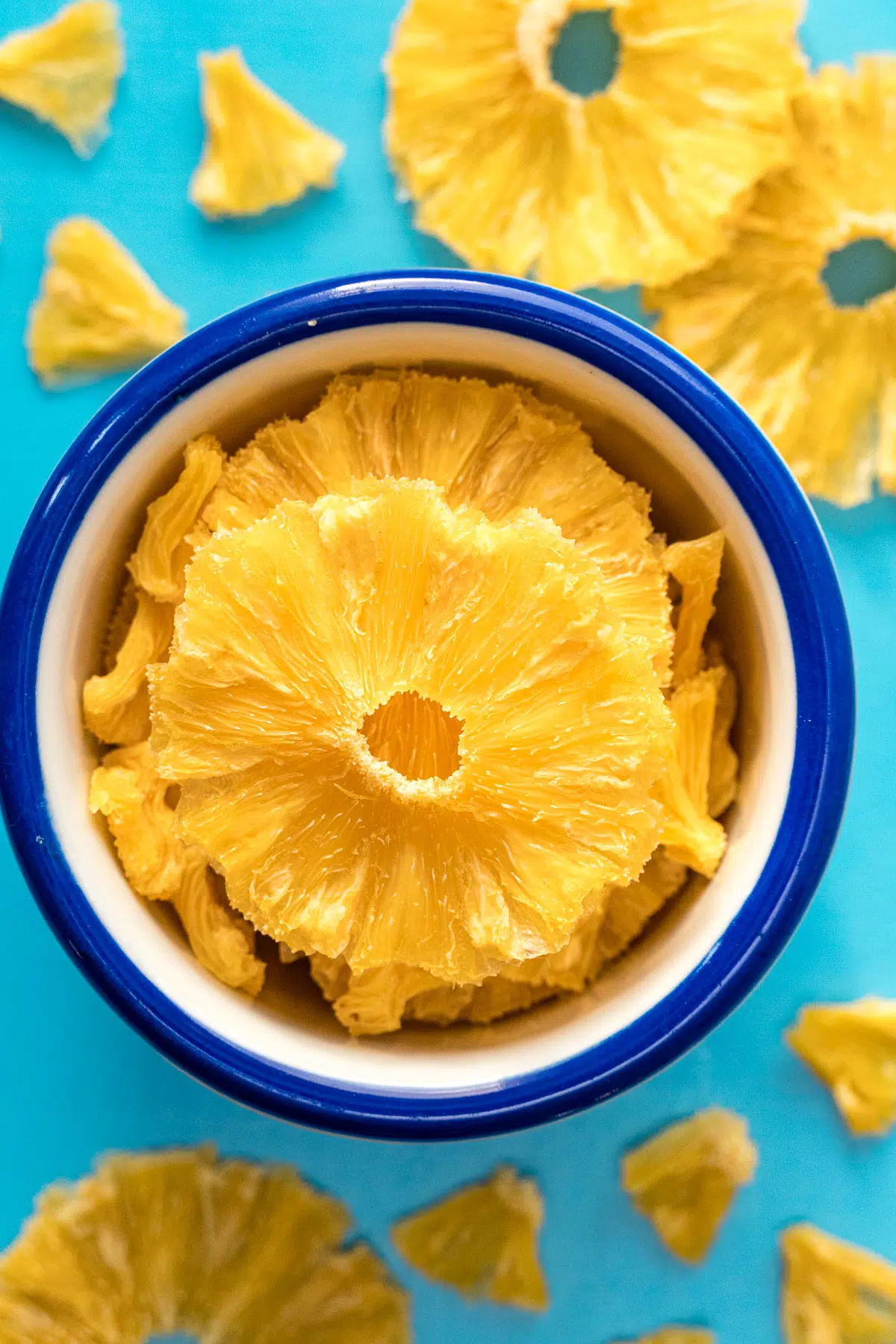
We absolutely love the taste of pineapple but the whole peeling, coring, and slicing can be a bit of a production. Even if you do own a pineapple corer, it’s not exactly a grab-and-go sort of fruit. But that’s where dehydrated pineapples come in!
Dehydrated pineapple distills all the incredible flavor down into portable, chewy bite-sized pieces that are perfect for munching during a day hike. Do all the prep-work in the comfort of your home kitchen and then enjoy the good parts when you’re out and about.
Dehydrated pineapple is obviously delicious on its own, but it also makes a great addition to trail mixes, added to oatmeal with coconut flakes, or can be used as a cocktail garnish.
So if you’re looking for a trail snack that tastes like a tropical breeze, then this article is for you.
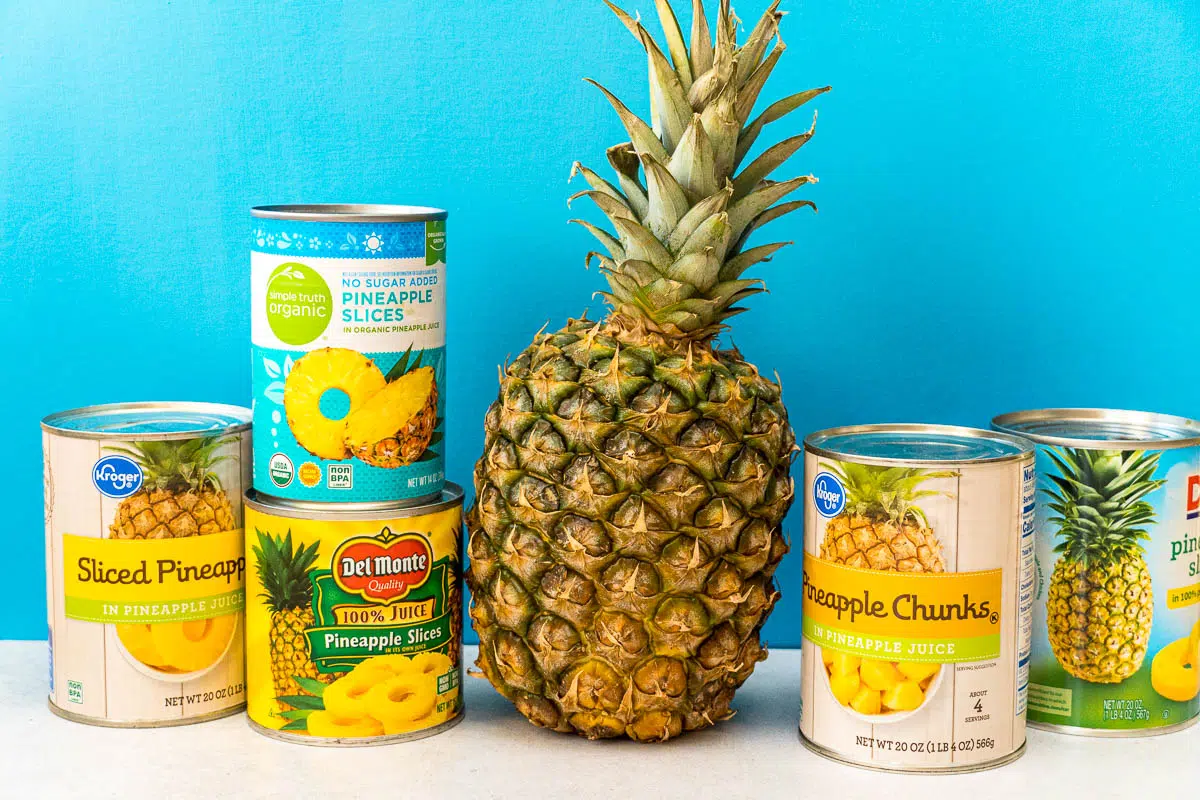
What Types Of Pineapples Can Be Dehydrated?
You can dehydrate either canned or fresh pineapple. Canned pineapple is obviously easiest because it comes pre-peeled and pre-cored. The fruit is also guaranteed to be ripe. Either rings or diced pineapple work well.
Knowing exactly when fresh pineapple is fully ripe is a bit of an art. The exterior skin will transform from a green to a more uniformly yellow hue, it will become slightly softer when squeezed, and the bottom of the pineapple will become fragrant.
Most fresh pineapples purchased at the grocery store may need up to a week or so to fully ripen (they are often sold very unripened).
Prepping Pineapple for Dehydrating
Before you start prepping your pineapple, make sure your counters, equipment, and hands are clean & sanitized to prevent contamination, which can spoil your batch down the line.
- If you’re using canned pineapple, all you have to do is open the can and drain!
- If you’re using fresh pineapple, you’ll need to remove the tough outer layer and core before cutting it into pieces. Cut off the top and bottom of the pineapple, then place it upright on your cutting board and cut down along the sides to remove the skin. Then, slice the pineapple in half, and then cut each of those in half again. Cut the pale core off each pineapple quarter at an angle. From here, you can cut the pineapple into smaller pieces—aim for about ½” or smaller for quicker drying time.
Equipment Spotlight: Dehydrators
If you’re in the market for a dehydrator, we recommend buying one with an adjustable temperature. This will allow you to dial in the drying temp to give you the best results for individual ingredients. The dehydrator we recommend (and use) most often is the COSORI Premium. You can also check out our best dehydrators post for a comparison of all the dehydrators we’ve used and would recommend.
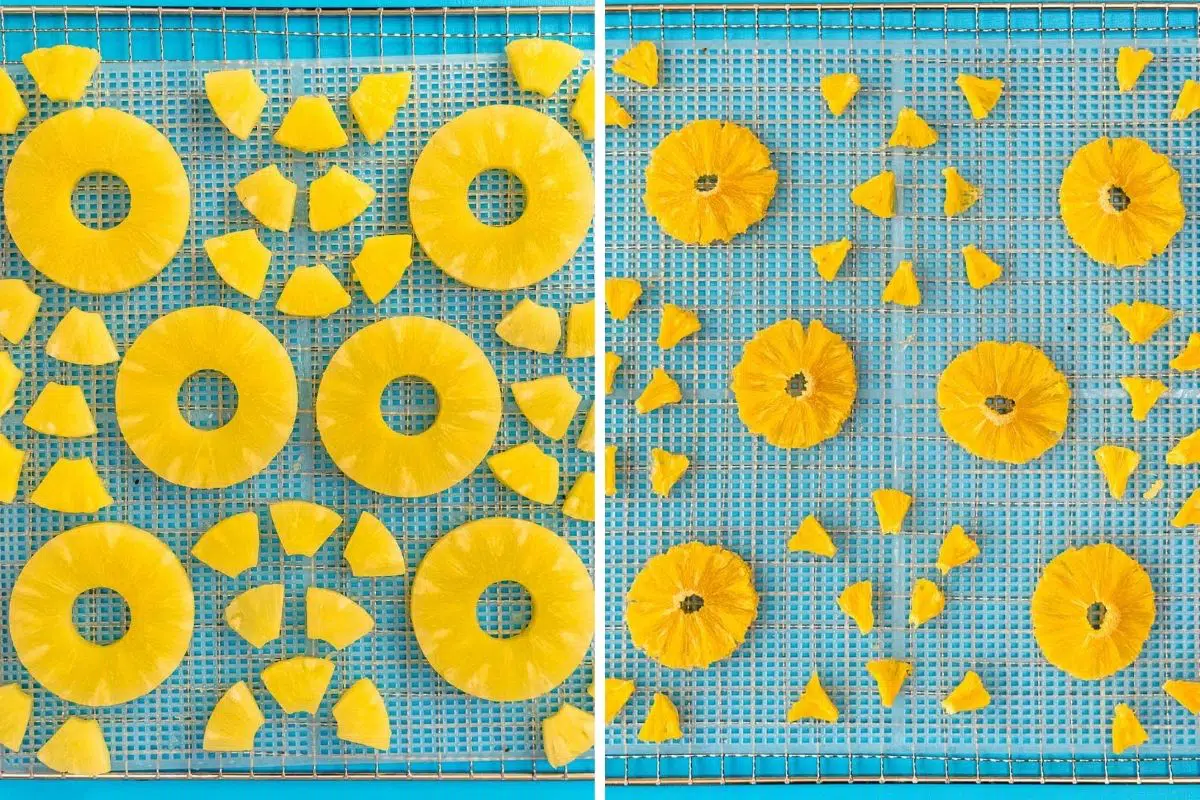
How To Dehydrate Pineapple
Once your pineapples are prepped, set up your dehydrator and follow these steps:
Arrange the pineapples on your dehydrator trays. Leave space between the pieces to allow air to circulate. If your dehydrator trays have large holes, a mesh liner may be needed to prevent smaller segments from falling through the holes.
Dehydrate at 135ºF (52ºC) for 8-16 hours until the pineapples are dry.
Depending on your machine, you may need to rotate the trays every so often to promote even drying.
How To Tell When Pineapples Are Done
Pineapple pieces or rings will be pliable when they are done. To test, remove a piece and let it completely cool. It will have some bend but if you cut it in half and squeeze it, there should be no moisture that seeps out. If there are any signs of remaining moisture, put them back into the dehydrator or oven to dry longer.
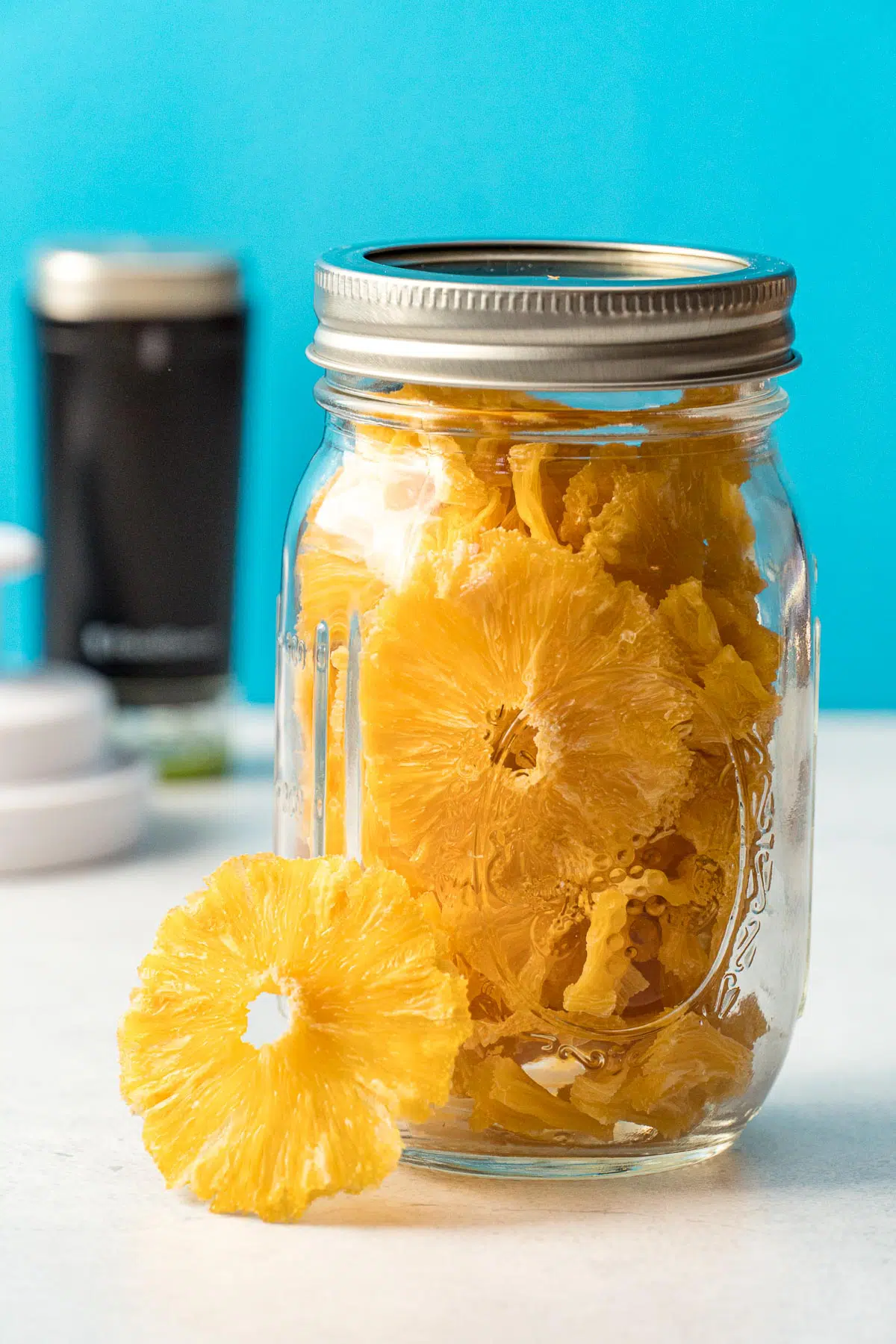
How To Store
If you’re dehydrating pineapple for snacking and plan on eating them within a week or two, you can store them in a sealed container or zip-top bag on the counter or in your pantry. Just let them cool and place them in a sealed container. We like to use these reusable ReZip bags.
However, when properly dried and stored, dehydrated pineapples can last up to a year. Here are our tips for long term storage:
- Let the pineapples cool completely before transferring them.
- Condition: Loosely pack the pineapples in a transparent airtight container. Check it daily for a week to check for signs of moisture or condensation, and shake to help prevent the slices from sticking together. If signs of moisture appear, stick them back into the dehydrator (as long as there’s no mold—in that case, toss the batch). After a week, if there’s no signs of moisture or mold, you can package them for long-term storage.
- Store in a clean, airtight container. For longer shelf life, vacuum seal.
- Use a moisture absorbing desiccant packet if you anticipate opening the container often, or if you live in an area with high humidity.
- Label the container with the date and any other important details
- Place the container in a cool, dark, and dry place—inside of a pantry cabinet works well.
Vacuum Sealing Tips
We like to store our dehydrated food in mason jars that have been vacuum-sealed using this handheld FoodSaver vacuum sealer along with these jar sealing attachments. This gives us the benefit of vacuum sealing without the waste (and expense) of plastic vacuum sealing bags. Since the jars are clear we make sure we store them in a dark spot in our pantry to keep them out of direct light.
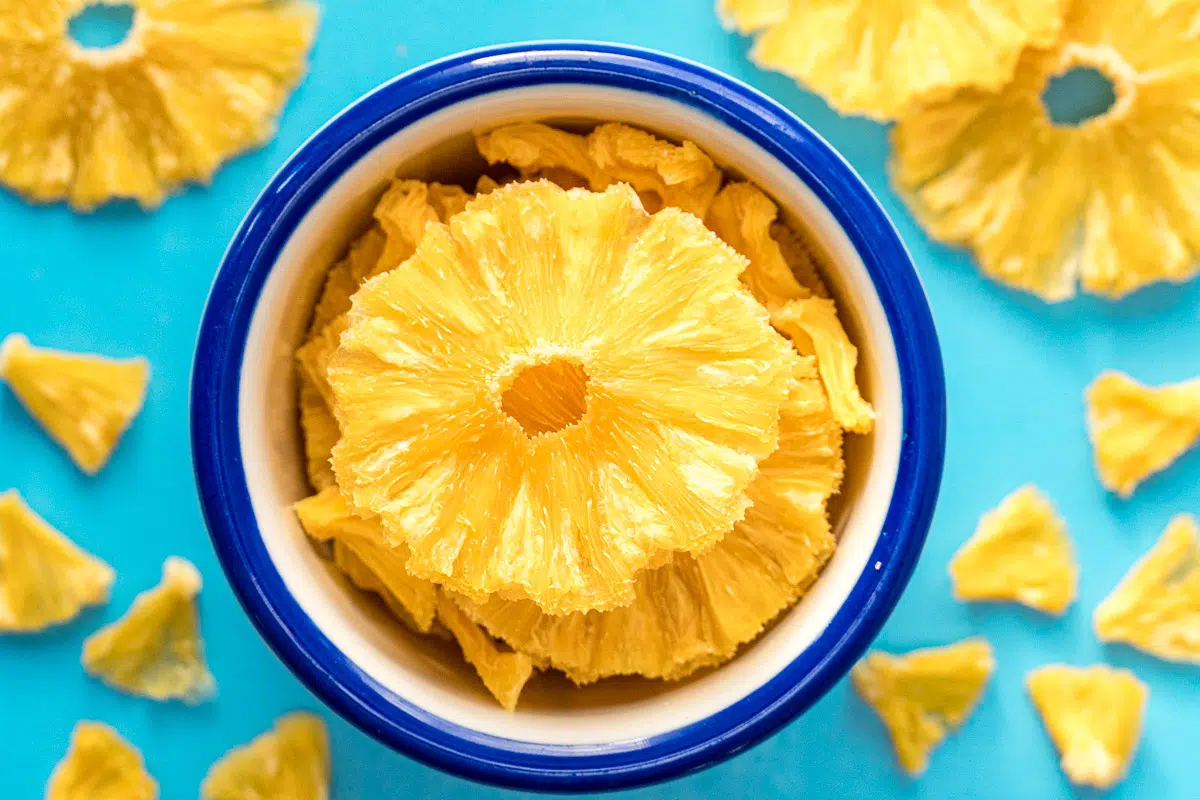
How To Use
Dehydrated pineapples are great to have on hand as a healthy snack, but here are a few more ideas on how to use them:
- Add to trail mix
- Top oatmeal or yogurt with chopped pieces
- Add to granola
- Garnish for cocktails
- Include as part of a cheese plate or charcuterie board
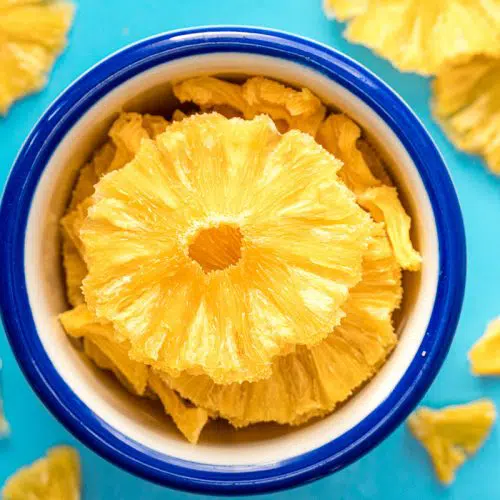
Equipment
- Airtight storage container
- Vacuum sealer (optional)
Ingredients
- 2 lb pineapple (canned or fresh), see note 1
Instructions
- Start with clean hands, equipment, and countertops.
- If using canned pineapple, drain the juice and then place the pineapple on dehydrator trays. Use a mesh liner for pineapple chunks.If using fresh pineapple, cut off the top and bottom, then place it upright on your cutting board and cut down along the sides to remove the skin. Then, slice the pineapple in half, and then cut each of those in half again. Cut the pale core off each pineapple quarter at an angle. From here, cut the pineapple into smaller pieces—aim for about ½” or smaller for quicker drying time.
- Dehydrate at 135°F / 57°C for 10-18 hours until dry (see Note 2).
Storage Tips
- Let the dried pineapple cool completely before storing.
- Short-term storage: If pineapple will be consumed within a week or to, store in a ziptop bag or sealed container on the counter or in a pantry.
- Long-term storage: Condition by loosely packing the dried pineapple in a transparent, airtight container. Leave it on the counter for a week and check it daily for signs of moisture. If condensation appears, return the pineapple to the dehydrator (unless there are signs of mold—then, throw out the whole batch). Shake occasionally to keep the pineapple from sticking together.
- After conditioning, store in an airtight container in a cool, dark place for up to a year. Vacuum sealing will help extend the shelf life and quality of the pineapple.
